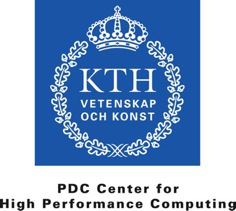Speakers
Mr
Antonios Monokrousos
(KTH Mechanics)Mr
Peter Lenaers
(KTH Mechanics)Dr
Philipp Schlatter
(KTH Mechanics)
Description
High Performance Computing (HPC) has matured into a well established tool for cutting edge
studies in fluid mechanics, both within academic research as well as at the corresponding
areas of industry (aeronautics, vehicle, energy etc). Within KTH Mechanics, Computational
Fluid Dynamics (CFD) also has a long tradition, dating back more than 25 years. The last few
years have been dominated by an increase in computer power and a clear trend towards
large-scale parallelism, allowing us to study more complex geometries, which include involved
physics, and reaching up to higher Reynolds numbers.
In principle, we attempt to solve the well-known Navier-Stokes equations, which are known
to be the governing equations for laminar, transitional and turbulent flows. However, due to
the non-linearity and chaotic behaviour of these equations (turbulence!), large grids are
necessary: We have recently performed simulations with up to 10 billion grid points, and also
run our codes on up to 32,000 processors. Most of the computations are performed with
parallel in-house codes or open-source codes available through collaboration with other
research groups. It turns out that HPC applications in CFD are usually limited by processor
speed and communication/network performance for large parallel jobs, which highlights the
need for both tightly connected parallel machines, and continuing development of research
codes (e.g. hybird parallelisation OpenMP/MPI).
A few of the highlights of the research at KTH Mechanics involving HPC resources are shown
on the posters. Our activities can roughly be categorised into three areas: Turbulence
(including geophysical flows), flow stability and flow control.
A) A fully turbulent spatially developing turbulent boundary layer has been studied with fully
resolved simulations: The simulated area, which is among the largest studied so far, would
cover a section of 20cm x 1 cm on a Airbus A380 wing. As shown in the poster, special focus
is laid on extracting the turbulent structures, which might give indications as to understand
the intrinsic dynamics of turbulence close to walls.
B) Stability of the flat-plate boundary layer flow was studied first without and at a later stage
including the leading edge of the plate. So-called optimal disturbances to the laminar flow
were computed and analysed enabling the study of the transition process from laminar to
turbulent boundary layers. It turns out that the leading edge inclusion is relevant to the
receptivity of the boundary-layer flow to external disturbances.
C) A fully three-dimensional diffuser was modelled for moderately high Reynolds number
where the flow was fully turbulent and three-dimensional separation occurred. In this
project, we could for the first time match the simulations with experimental results obtained
in a very advanced lab based on MRI-scanners. With the computer results it was possible to
visualize the time-dependent three-dimensional phenomena inside the diffuser. Increased
understanding of such flow situations is relevant to many areas of science and engineering.
These results show that HPC plays an integral part in fluid dyanamics. With that we would
like to acknowledge the support and computer time provided by SNIC and PDC, which helped
us during all these years to perform this exciting research.
Primary authors
Prof.
Dan Henningson
(KTH Mechanics)
Dr
Philipp Schlatter
(KTH Mechanics)
Co-authors
Mr
Antonios Monokrousos
(KTH Mechanics)
Mr
Peter Lenaers
(KTH Mechanics)

